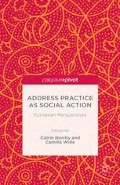Abstract
The chapter investigates address practices in 318 audio-and video-recorded service encounters at theatre box offices and other booking venues equally distributed across the two national varieties of Swedish, Sweden Swedish and Finland Swedish. The results demonstrate compelling variation in address choices, which can be linked to participant roles (customer-staff), generation (below and above 50 years) and national variety. Overall informal address with T (du) is the most common address form in both varieties and is particularly salient among older customers in Sweden. There are few occurrences of V address in the data, and most are found among younger Finland-Swedish staff.
Access this chapter
Tax calculation will be finalised at checkout
Purchases are for personal use only
Preview
Unable to display preview. Download preview PDF.
References
Ahlgren, P. (1978) Tilltalsordet ni. Dess semantik och användning i historiskt perspektiv, Uppsala: Almqvist and Wiksell.
Brown, R. and Gilman, A. (1960) ‘The pronouns of power and solidarity’ in T. A. Sebeok (ed.) Style in Language, Cambridge, MA: MIT Press, pp. 253–76.
Brown, P. and Levinson, S. (1987) Politeness. Some Universals in Language Usage, Cambridge: Cambridge University Press.
Charles, M.-L. and Louhiala-Salminen, L. (2007) ‘Vems språk talas, vilken är verksamhetskultur? Intern kommunikation och språkval i finsk-svenska fusionerade företag’ in O. Kangas and H. Kangasharju (eds) Ordens makt och maktens ord, Helsinki: The Society for Swedish Literature in Finland, pp. 416–47.
Clyne, M. (1992) ‘Pluricentric languages–Introduction’ in M. Clyne ed.) Pluricentric Languages Berlin: Mouton de Gruyter, pp. 1–9.
Clyne, M., Norrby, C. and Warren, J. (2009) Language and Human Relations. Styles of Address in Contemporary Language, Cambridge: Cambridge University Press.
Drew, P. and Heritage, J. (1992), ‘Analyzing talk at work: An introduction’ in P. Drew and J. Heritage (eds) Talk at Work, Cambridge: Cambridge University Press, pp. 3–65.
Fremer, M. (1996) Personlig referens i servicesituationer. Svenska och finska samtal från Helsingfors, Stockholm och Uppsala i en jämförande analys, MA thesis Helsinki: University of Helsinki.
Laine-Sveiby, K. (1991) Företag i kulturmöten. Tre finländska företag och deras dotterbolag. En etnologisk studie, Stockholm University: Department of Ethnology.
Liebkind, K., Moring, T. and Tandefelt, M. (eds) (2007) The Swedish-speaking Finns, International Journal of the Sociology of Language, 187/188 (special issue), 1–227.
Linell, P. (1990) ‘De institutionaliserade samtalens elementära former: om möten mellan professionella och lekmän’, Forskning om utbildning, 17, 18–35.
Mårtensson, E. (1986) ‘Det nya niandet’, Nordlund 10, Lund: Department of Scandinavian Languages, 35–79.
Nelson, M. (2014) ‘You need help as usual, do you? Joking and swearing for collegiality in a Swedish workplace’, Multilingua — Journal of Cross-cultural and Interlanguage Communication, 33.1–2, 173–200.
Norrby, C., Wide, C., Lindström, J. and Nilsson, J. (2015) ‘Interpersonal relationships in medical consultations. Comparing Sweden Swedish and Finland Swedish address practices’, Journal of Pragmatics, 84, 121–38.
Paulston, C. Bratt (1976) ‘Pronouns of address in Swedish: Social class semantics and changing system’, Language in Society, 5.3, 359–86.
Pettersson, T. and Nurmela, S. (2007) Om olika sätt att möta en stor elefant. En jämförande studie av finländsk och svensk kultur, Esbo and Stockholm: The Swedish Finnish Cultural Foundation.
Reuter, M. (1992) ‘Swedish as a pluricentric language’ in M. Clyne (ed.) Pluricentric Languages. Different Norms in Different Nations, Berlin: Mouton de Gruyter, pp. 111–16.
Saari, M. (1995) ‘ “Jo, nu kunde vi festa nog”. Synpunkter på svenskt språkbruk i Sverige och Finland’, Folkmålsstudier, 36, 75–108.
Saari, M. (2012) ‘The development of Finnish into a national language’ in M. Hüning, U. Vogl and O. Moliner (eds) Standard Languages and Multilingualism in European History, Amsterdam: Benjamins, pp. 179–204.
Statistics Finland (2015) Population, Helsinki: Statistics Finland, http://www.tilastokeskus.fi/tup/suoluk/suoluk_vaesto_en.html, date accessed 5 March 2015.
Statistics Sweden (2015) Population Statistics, Stockholm: Statistics Sweden, http://www.scb.se/en_/Finding-statistics/Statistics-by-subject-area/Population/Population-composition/Population-statistics, date accessed 5 March 2015.
Tykesson-Bergman, I. (2006) Samtal i butik. Språklig interaktion mellan biträden och kunder, Stockholm: Almqvist and Wiksell.
Wide, C. and Lyngfelt, B. (2009) ‘Svenskan i Finland, grammatiken och konstruktionernâ’ in C. Wide and B. Lyngfelt (eds) Konstruktioner I finlandssvensk syntax. Skriftspråk, samtal och dialekter, Helsinki: Svenska litteratursällskapet i Finland, pp. 11–43.
Yli-Vakkuri, V. (2005) ‘Politeness in Finland: Evasion at all costs’ in L. Hickey and M. Stewart (eds) Politeness in Europe, Clevedon: Multilingual Matters, pp. 189–203.
Editor information
Editors and Affiliations
Copyright information
© 2015 Catrin Norrby, Camilla Wide, Jenny Nilsson and Jan Lindström
About this chapter
Cite this chapter
Norrby, C., Wide, C., Nilsson, J., Lindström, J. (2015). Address and Interpersonal Relationships in Finland-Swedish and Sweden-Swedish Service Encounters. In: Norrby, C., Wide, C. (eds) Address Practice As Social Action: European Perspectives. Palgrave Pivot, London. https://doi.org/10.1057/9781137529923_5
Download citation
DOI: https://doi.org/10.1057/9781137529923_5
Publisher Name: Palgrave Pivot, London
Print ISBN: 978-1-137-52991-6
Online ISBN: 978-1-137-52992-3
eBook Packages: Palgrave Social Sciences CollectionSocial Sciences (R0)

